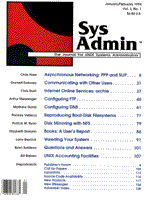
Sidebar: Required Mini-Root Functions
The mini-root provides basic operating system functionality by employing a memory-based filesystem containing a handful of operating system commands. Often a mini-root is used by a vendor to facilitate loading system software from a distribution medium onto the boot-disk. A mini-root can also be used by a system administrator to salvage or restore the root partition of the boot-disk if the disk has become corrupted and cannot boot. All mini-roots are not the same, and some vendors will even customize one for you (for a price). In any event, the mini-root must be able to do the following in order to perform the procedure presented here:
|